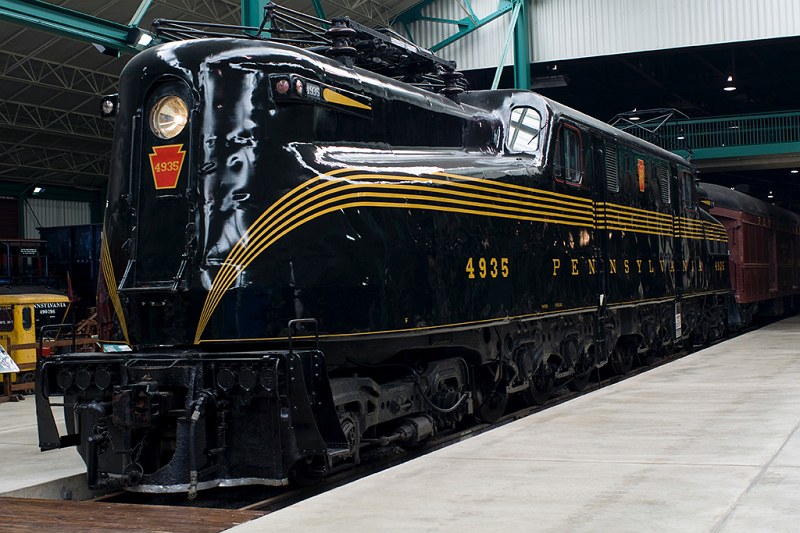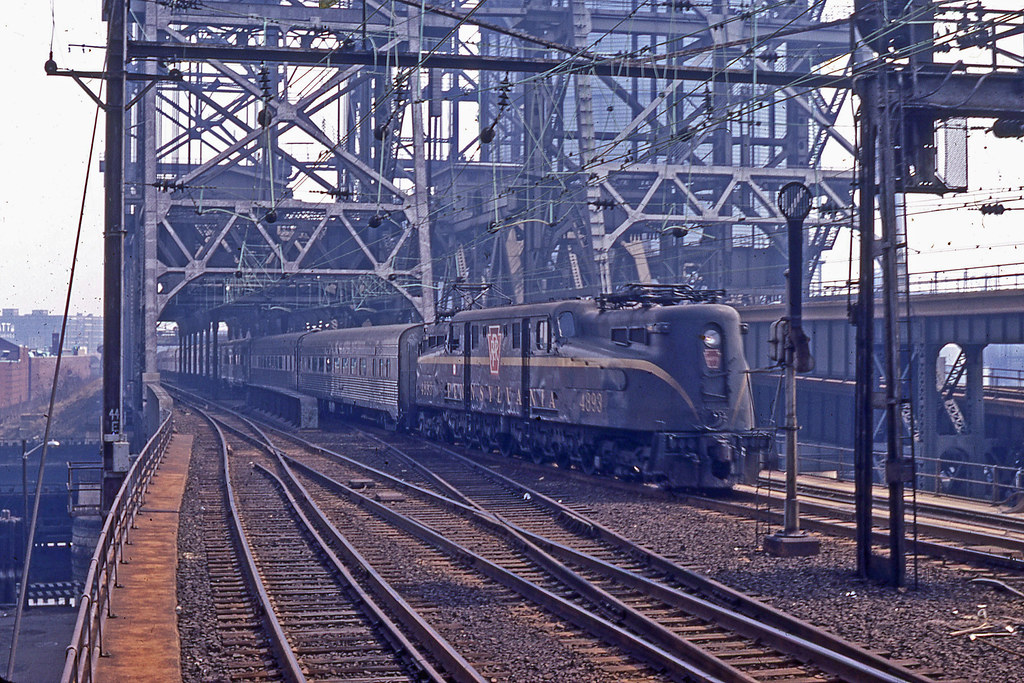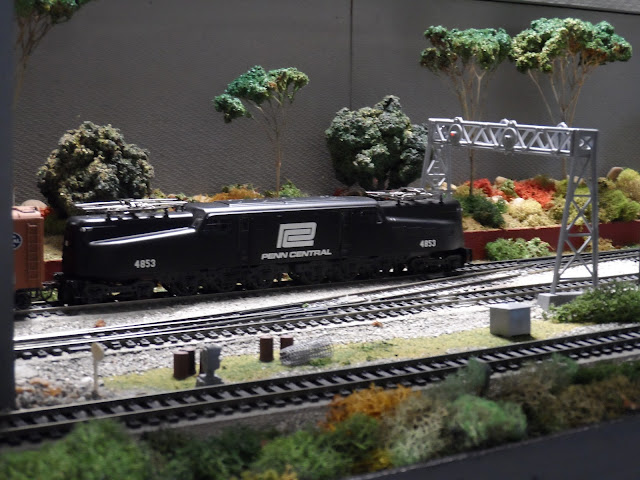Greetings All,
Locomotive Spotlight #4-2024
Revisiting the Legendary GG1
Welcome to another installment of the locomotive spotlight series!! Today the spotlight will shine on the legendary GG1. A recent purchase of a Bachmann HO Scale Penn Central GG1 was the catalyst to revisit some of the information of this iconic locomotive.
Prototype Information
Why a GG1?
The Pennsylvania Railroad became dissatisfied with its electric P5a 2-C-2 electric motors in the early 1930s which prompted the PRR to try a 2-C-C-2 locomotive classified as a GG1. After a P5a grade crossing accident in January, 1934 where the engineer was killed the center cab design was sought for better crew protection which resulted in Donald Dohner's center cab GG1 design.
"PRR P-5a passenger locomotive made by GE 4-5-1933 [GE news photo]" by over 26 MILLION views Thanks is licensed under CC BY-NC-SA 2.0. To view a copy of this license, visit https://creativecommons.org/licenses/by-nc-sa/2.0/?ref=openverse.
Who Designed the first GG1?
Not Raymond Lowey!!
So said the headline in the Classic Trains Summer 2009 issue highlighting the GG1. The CT article by Hampton C. Wayt credits Donald R. Dohner a well known industrial designer of the period with the design of the GG1 and the 4800 which became known as "Rivets" based on its construction.
"RR2000.20 GG1 PRR 4800 Plate" by Photo by and (c)2014 Derek Ramsey (Ram-Man) is licensed under CC BY-SA 4.0. To view a copy of this license, visit https://creativecommons.org/licenses/by-sa/4.0/?ref=openverse.
Who?
Donald Roscoe Dohner, born in 1892, was highly regarded as both an industrial designer and design educator. In 1934 he started the first degree granting industrial design program in the United States at Carnegie Institute of Technology (now Carnegie-Mellon University) in Pittsburgh. One year later he moved to Pratt Institute in Brooklyn, NY where he developed the industrial design curriculum that has made Pratt one of the leading design programs to this day.
"Pratt Institute- Engineering Building" by Raleene is licensed under CC BY-NC-ND 2.0. To view a copy of this license, visit https://creativecommons.org/licenses/by-nc-nd/2.0/?ref=openverse.
Mr. Dohner began his career in East Pittburgh with the Westinghouse Electric & Manufacturing Company (WEMCo) for which in 1930 he was named head of the new "Art in Engineering Department". In this capacity he was in charge of designing products in all 25 WEMCo plants across the country. Mr. Dohner was credited with designing 128 products from ashtrays to locomotives during his four year tenure at WEMCo.
"Inauguration of electrification on the Santiago - Valparaiso line, locomotive 2806 from Baldwin-Westinghouse, at Santiago Mapocho on October 10, 1924 (official photograph/ coll. Dietrich Angerstein)" by santiagonostalgico is licensed under CC BY-ND 2.0. To view a copy of this license, visit https://creativecommons.org/licenses/by-nd/2.0/?ref=openverse.
In 1934 Mr. Dohner was part of the design team of the GG1 that was engineered at Baldwin Locomotive Works under the direction of consultant engineer George Gibbs along with representatives from General Electric, Westinghouse, PRR, Baldwin and Gibbs own company Gibbs & Hill. Mr. Dohner contributed three design models that eventually became GG1 #4800 that was built by General Electric with Westinghouse controls and a Baldwin Chassis..
Where Did He Go?
The PRR hired Raymond Loewy in November 1934 to further the development of the GG1 design for mass production. Mr. Loewy and the PRR promoted him as the father of the GG1 while Mr. Dohner, an employee of Westinghouse, was a modest man who chose to espouse design technique rather than himself. This modesty combined with an early death has left him all but forgotten.
GG1 Fun Facts
GG1 4800 was built at the Baldwin's Philadelphia Shop
GG1 4701 - 4938 were built at the PRR Juniata Shops (Altoona), with GE motors and Westinghouse controls.
Wheel Arrangement: 2-C-C-2
Total Weight: 477,000 pounds
Continuous Horsepower: 4,620 (9,240 for a short time)
Maximum Speed: Passenger: 100 MPH. Freight: 90 MPH
Power Source: Catenary Wire (11,000 volts, single phase, 25 cycles)
Length: 79'6"
Height : 15'0"
How Rugged were the GG1s?
The 4876 pictured below became famous on January 15th, 1953 when it crashed thru the track 16 bumping post at Washington Union Station after being unable to stop when it arrived with the overnight Federal Express from Boston. The 4876 destroyed the station newsstand and plummeted into the basement below. Miraculously no one was killed. An angle cock had vibrated shut disabling the air brakes on thirteen of the train's sixteen cars. Cut apart and taken to Altoona for rebuilding the 4876 is back on the rails before years end.
"PRR 4876 GG1" by CaptainCutler is licensed under CC BY-SA 2.0. To view a copy of this license, visit https://creativecommons.org/licenses/by-sa/2.0/?ref=openverse.
Reliability
The only major electro-mechanical breakdown of the GG1 was caused by a February 1958 blizzard that swept across the northeastern United States and put nearly half of the GG1s out of commission. Exceptionally fine snow, caused by the extreme low temperatures, passed through the traction motors' air filters and into the electrical components. When the snow melted, it short-circuited the components. On about 40 units, the air intakes were later moved to a position under the pantographs.
Rivets Close Up
In 1935 GG1 4800 powers the first official electric train out of Washington D.C. on January 28th.
"'Old Rivets' GG1 #4800" by blind squirrel snapography is licensed under CC BY-NC-ND 2.0. To view a copy of this license, visit https://creativecommons.org/licenses/by-nc-nd/2.0/?ref=openverse.
"GG1 used for PRR passenger and freight service in 1935" by over 25 MILLION views Thanks is licensed under CC BY-NC-SA 2.0. To view a copy of this license, visit https://creativecommons.org/licenses/by-nc-sa/2.0/?ref=openverse.
GG1 #4935 was restored to the dark green and pinstripes by Amtrak in 1977. Here it is cosmetically restored and on display at the Railroad Museum of Pennsylvania.
"File:Retired PRR GG1 at Railroad Museum.jpg" by Pheanix is licensed under CC BY 2.0. To view a copy of this license, visit https://creativecommons.org/licenses/by/2.0/?ref=openverse.
The GG1s were PRR livery trendsetters with the above 4935 ushering in the dark green five strip scheme that would be used on its early diesel cab units. The 4890 below shows the Tuscan red scheme that was be applied to the diesel cab passenger fleet starting in 1952.
"PRR GG1 4890 at NRM, Green Bay, 20040426" is licensed under CC BY-SA 2.0. To view a copy of this license, visit https://creativecommons.org/licenses/by-sa/2.0/?ref=openverse.
In 1967 as part of a federally funded Northeast Corridor Project PRR's October 29 timetable includes New York-Washington schedules that call for train speeds of 100 MPH to be powered by GG1s that are 24 years old.
"PRR GG1 No. 4893 pulls passenger train at Newark NJ 1967" by over 25 MILLION views Thanks is licensed under CC BY-NC-SA 2.0. To view a copy of this license, visit https://creativecommons.org/licenses/by-nc-sa/2.0/?ref=openverse.
The GG1s were more than up to the task!!! The Giant keystones were introduced in 1955.
"Pennsylvania RR GG1 at Newark NJ 1967" by over 26 MILLION views Thanks is licensed under CC BY-NC-SA 2.0. To view a copy of this license, visit https://creativecommons.org/licenses/by-nc-sa/2.0/?ref=openverse.
The New Black
On February 01, 1968 119 surviving GG1s were conveyed to the Penn Central upon the merger of the PRR and the NYC. The GG1s would retain their original 4800-4938 numbers.
"PC 4879 DC Union Station May 1976xRP" by drewj1946 is licensed under CC BY 2.0. To view a copy of this license, visit https://creativecommons.org/licenses/by/2.0/?ref=openverse.
On May 1st, 1971 Amtrak took over the intercity passenger rail operations and would lease 21 of the PC GG1s.
Amtrak would also purchase 30 GG1s for Northeast Corridor passenger service and New York & Long Branch commuter service renumbering them into the 900 series and then later adding the 4 prefix back to the GG1s.
"Amtrak No 904" by Tim_kd5urs is licensed under CC BY-SA 2.0. To view a copy of this license, visit https://creativecommons.org/licenses/by-sa/2.0/?ref=openverse.
A Bloody Nose!
In 1972 Amtrak painted six GG1s in the red, blue and silver scheme known as "the circus", WC Fields and Rudolph schemes by railfans.
"Amtrak 926" by Mobilus In Mobili is licensed under CC BY-SA 2.0. To view a copy of this license, visit https://creativecommons.org/licenses/by-sa/2.0/?ref=openverse.
Another Owner
On April 1st, 1976 Conrail picked up the pieces of the bankrupt Northeastern railroads and inherits the Penn Central GG1s. CR would us 68 GG1s for freight service until 1980 when Conrail electric operations ended.
"PRR GG1 locomotives in Claymont DE, Jan 9th, 1977" by WES is licensed under CC BY 2.0. To view a copy of this license, visit https://creativecommons.org/licenses/by/2.0/?ref=openverse.On April 12th, 1976 the 4800, Old Rivets, rolls out of the Conrail Altoona Paint Shop in a star spangled paint job in honor the USA bicentennial.
"File:Conrail 4800 at Wilmington Shops, August 29, 1976.jpg" by WES from same place, USA is licensed under CC BY 2.0. To view a copy of this license, visit https://creativecommons.org/licenses/by/2.0/?ref=openverse.
All electric motor maintenance for the PRR, PC, CR and Amtrak took place at the Wilmington, Delaware shop.
"GG1 locomotives at Wilmington Shops, August 1976" by WES from same place, USA is licensed under CC BY 2.0. To view a copy of this license, visit https://creativecommons.org/licenses/by/2.0/?ref=openverse.
End of the Line
Ten months shy of the class's 50th Anniversary, New Jersey Transit retired the last active GG1s, 4877, 4879 and 4882 after a day of Newark-Matawan farewell trips on October 29th, 1983. Not a single GG1 has run since. GG1s 4872-4884 were conveyed to NJ Transit in 1976.
"Railroad262" by Bengt 1955 is licensed under CC BY-NC 2.0. To view a copy of this license, visit https://creativecommons.org/licenses/by-nc/2.0/?ref=openverse.
"Railroad262" by Bengt 1955 is licensed under CC BY-NC 2.0. To view a copy of this license, visit https://creativecommons.org/licenses/by-nc/2.0/?ref=openverse.
The Models
The newest GG1 model to join my fleet is a Bachmann red box product that comes with DCC and Sound.
The model is a factory new purchase and ready for unboxing.
After a break in period and some lubrication the 4853 is ready for its first revenue run.
The 4853 heads towards RA Tower on the lower level of the layout where my electric motors mostly run so the lack of catenary is as apparent.
The 4853 passes RA Tower. The lower level is also used as my New Haven RR connection. In 1969 the PC began running their GG1s in passenger service from Washington DC to New Haven, CT.
GG1 4853 sits at Empire City Station with a TOFC train.
On another day the 4853 is hauling an Amtrak train thru the station as a TOFC train is powered by a PC GP40 and APRR GP38.
After a break in period and some lubrication the 4853 is ready for its first revenue run.
The 4853 heads towards RA Tower on the lower level of the layout where my electric motors mostly run so the lack of catenary is as apparent.
The 4853 passes RA Tower. The lower level is also used as my New Haven RR connection. In 1969 the PC began running their GG1s in passenger service from Washington DC to New Haven, CT.
GG1 4853 sits at Empire City Station with a TOFC train.
On another day the 4853 is hauling an Amtrak train thru the station as a TOFC train is powered by a PC GP40 and APRR GP38.
Other GG1s in the Combined Family Fleet
PRR GG1 4800. This is an IHC Premier model with no rivets in sight!! The 4800 was restored to this 1935 livery in 1982.
GG1 4910 another IHC Premier model passes with the Congressional which spurred the change to Tuscan Red for PRR passenger service locomotives.
GG1 4935 was restored to its original PRR livery by Amtrak in 1977. This is also an IHC Premier model.
GG1 4910 another IHC Premier model passes with the Congressional which spurred the change to Tuscan Red for PRR passenger service locomotives.
GG1 4935 was restored to its original PRR livery by Amtrak in 1977. This is also an IHC Premier model.
The end of an era of Northeast Corridor dominance by the GG1s is approaching and it is the beginning of a new era of NE Corridor dominance by the AEM-7.
PC GG1 #4853 in action
Final Thoughts and Comments
Is the GG1 the most famous locomotive of all time? It certainly has a pedigree of reliability, length of service, iconic design and time tested appeal after serving five different owners for almost five decades.
A Minor Glitch
The Bachmann red box GG1 ran very well in one direction during the break in period but when I reversed the direction the truck tower bearings started squealing loudly. I took the shell off by removing the four screws and oiled both bearings. After that the GG1 has run perfectly.
Additional Reading and Links
NYCTL GG1 Blog Post December 2021
Classic Trains Summer 2009 Issue
GG1 Roster and Dispositions
Wikipedia GG1 Page
Thanks for reading and watching!!!
See you soon!!





























This comment has been removed by the author.
ReplyDeleteThis has to be one of my favorite locomotive updates that I've seen you do! The GG1 is by far one of my favorite engines; if not THE favorite engines that I own.
ReplyDeleteThe background information you posted was very interesting to read and of course, enjoyable.
Nice to see the new Bachmann GG1 engine running its paces on the NYCTL and the photos of your other GG1 engines in your fleet.
Great work Sir John!!
Thanks for the compliments Sir Neal!!! Glad you liked the post and video!!
DeleteOne of the most iconic locomotives! Your post was a great read with the thorough history and background of the GG-1! The loco looked good is al of its liveries but I have to say that the large PC logo on black is my favorite. Nice work getting your GG-1 to run well with the rest of your collections of electrics!
ReplyDeleteThank you very much Ralph!!!
Delete